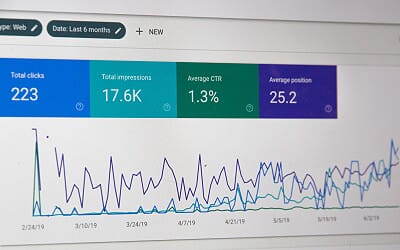Google Analytics 4 (or GA4) is the latest and greatest version of Google Analytics. It’s safe to say it hasn’t always been the most popular development in the digital marketing community… but we’ve had plenty of time to get ready for it. Despite all this skepticism, the people at Google have been describing GA4 as the “future of measurement”. But what does this actually mean? In this blog, we’ll cover exactly what GA4 is, how it compares to the previous version (Universal Analytics) and how it’s impacting digital PR.

Blog
What Is GA4 and What Does It Mean for Digital PR?
What is GA4?
Google Analytics is a tool that analyses how people use your website. It provides a complete picture of activity on the site, from simple things like which pages people are viewing to detailed tracking of your users’ journeys. The previous version, Universal Analytics (UA) has been around for about 10 years, but Google has recently made a change… and it’s a big one.
Starting 1st July 2023, all Universal Analytics users will be automatically transitioned to Google Analytics 4. GA4 has been introduced to provide more detailed customer insights and better focus on privacy. To achieve this, Google has completely changed how they measure user data, alongside a whole host of other updates. More data, more tracking options and more customisation – GA4 opens up new opportunities to refine your PR and marketing strategy.
GA4 vs Universal Analytics: The Impacts on Digital PR:
Different measurement metrics
GA4 takes a completely different approach to tracking. Where Universal Analytics tracked ‘hits and sessions’, GA4 now tracks ‘events’.
To put this into context, imagine you’re shopping on Amazon. You look at a few pages, put a product into your basket and then checkout. In UA, this would’ve been recorded as one session – made up of lots of different interactions. But in GA4, all of these interactions are recorded as separate events. This makes reporting much more flexible and accurate, as all of your actions can now be tracked individually. Outbound links, scrolls, file downloads – you can now measure more user activity, more easily.
This is great news for your digital PR campaigns. Events-based measurement means you can now more accurately track where users are coming from and how they’re interacting with your (or your client’s) website. So after successfully driving traffic through your PR campaigns, you can build a more accurate picture of customers’ activities through the site.
Cross-platform, cross-device and cross-domain tracking
GA4 also lets you track your users as they interact with your website across different devices, and even across different domains you own. Let’s say someone checks out your website on their computer, before visiting again on their phone later in the day. From here, they click a link to another website you own and download your company app. Previously, trying to measure this user journey would’ve been an absolute nightmare. But with GA4, you can more easily follow users as they move across platforms, devices and domains.
Another key benefit is that GA4 no longer solely relies on last click attribution. This means it’s not just the last bit of content or ad clicked on that gets the credit for a conversion – you can see all the actions a customer’s taken, no matter what their user journey looks like.
Once again, this is brilliant for digital PR. People typically need to view a product or service multiple times before purchasing, and clicking through a PR campaign could be one of the very first touchpoints. Using GA4, you’ll be able to follow this journey and attribute credit to the original campaign, which might’ve otherwise gone undetected. This attribution means you’re better able to understand and articulate campaign performance, while building a clearer picture of ROI.
Focus on engagement, not bounces
Another key difference is that now, Google has homed in on engagement as a separate metric.
In UA, if someone visited a page on your website, spent 5 minutes reading the content and then left – it would be classed as a bounce. But in reality, this person was probably very engaged with your content. To sort this out, Google has changed the way GA4 measures engagement. Now, an engaged session is when a user has stayed on the page for 10 seconds or longer, viewed more than one page or triggered a conversion event.
This helps you better understand the impact of your PR activities (and should nicely boost your reports). When people reach your website or app through PR placements, GA4 can provide a more accurate picture of how engaged they were with your content. No more unusually high bounce rates, it doesn’t matter if someone only views your campaign landing page – if they’re engaged, it’ll be recorded.
Lack of historical data
Google has announced that your historical data will not be accessible in GA4.
As mentioned, GA4’s measurement is completely different to UA, meaning migrating data over to your new property will be impossible. This means your GA4 property will be a complete fresh start – with none of your historical data. In fact, you’ll only have access to your old data until 1st July 2024, at which point it’ll be gone forever. So basically, save your data!
For PR, this means comparing the results of your campaigns with previous years will be a challenge. Not only is UA data measured differently, it’s not even accessible in GA4. So if you are comparing PR campaigns to any previous results, you’ll need to have saved your old UA data externally, and will probably need to add a few caveats to your reports too.
Interested in finding out how digital PR could transform your marketing strategy? Our digital PR experts can help. Get in touch at louise@energypr.co.uk.
We're always interested in a new PR challenge









